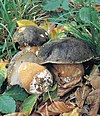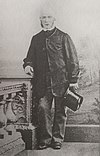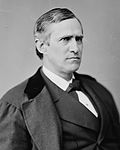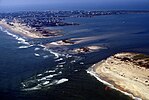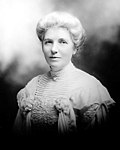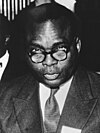Wikipedia:Today's featured article/September 2018
| << | Today's featured articles for September 2018 | >> | ||||
|---|---|---|---|---|---|---|
| Su | Mo | Tu | We | Th | Fr | Sa |
| 1 | ||||||
| 2 | 3 | 4 | 5 | 6 | 7 | 8 |
| 9 | 10 | 11 | 12 | 13 | 14 | 15 |
| 16 | 17 | 18 | 19 | 20 | 21 | 22 |
| 23 | 24 | 25 | 26 | 27 | 28 | 29 |
| 30 | ||||||
September 1
Messier 87 is a supergiant elliptical galaxy in the constellation Virgo. It has about 12,000 globular clusters—compared to the 150 to 200 orbiting the Milky Way—and a jet of energetic plasma that originates at the core and extends at least 4,900 light-years. One of the brightest radio sources in the sky, it is a popular target for both amateur and professional astronomers. The French astronomer Charles Messier discovered the galaxy in 1781, and catalogued it as a nebulous feature while searching for objects that would otherwise confuse comet hunters. About 53.5 million light-years from Earth, M87 is the second brightest galaxy within the northern Virgo Cluster. Unlike disk-shaped spiral galaxies, M87 has no distinctive dust lanes. Instead, it has an almost featureless ellipsoidal shape typical of most giant elliptical galaxies, diminishing in luminosity away from the center. It has a supermassive black hole at its core, powering an active galactic nucleus. (Full article...)
September 2
September 3
The Avenue Range Station massacre was the murder of at least nine Aboriginal Tanganekald people, who were shot by white settlers on the Avenue Range pastoral station in the colony of South Australia around September 1848, during the Australian frontier wars. Those confirmed to have been killed were an old blind man, three women, two teenage girls, and three female children, including a baby. The sheep farmer James Brown (pictured) and his overseer, Eastwood, were suspected, and Brown was charged with the murder of "unknown aboriginal natives" in March 1849. The magistrate who committed him for trial said that there was "little question of the butchery or the butcher". Further investigation was ordered, but by the November 1849 sittings of the Supreme Court in the colonial capital of Adelaide, the case had been dropped. At the time there were significant restrictions on the use of evidence given by Aboriginal witnesses, especially where a verdict could involve capital punishment. (Full article...)
September 4
"
September 5
The
Part of the History of the Manhattan Project featured topic.
- "Starvin' Marvin" (South Park)
- Avenue Range Station massacre
- Boletus aereus
September 6
- Metallurgical Laboratory
- "Starvin' Marvin" (South Park)
- Avenue Range Station massacre
September 7
"
- Babakotia
- Metallurgical Laboratory
- "Starvin' Marvin" (South Park)
September 8
September 9
The
September 10
D. Djajakusuma (1918–1987) was an Indonesian film director and promoter of traditional art forms. During the Japanese occupation from 1943 to 1945 he was a translator and actor. In the national revolution which followed, he worked for the military's educational division and several news agencies, as well as in drama. In 1951 he joined the National Film Corporation (Perfini) at the invitation of Usmar Ismail. After his directorial debut with Embun, he released a further eleven films with the company before leaving in 1964. He then returned to traditional Indonesian theatre, including wayang. Although he continued to direct movies, most of his energies were dedicated to promoting traditional art forms and teaching cinematography. His theatrical performances attempted to modernise traditional forms. He is credited with revitalising the Betawi theatre form lenong and received numerous awards for his filmmaking, including a lifetime achievement award at the Indonesian Film Festival. (Full article...)
September 11
The
September 12
September 13
The
September 14
September 15
The
Part of the Battleships of Germany featured topic.
September 16
Thomas F. Bayard (1828–1898) was a lawyer, politician, and diplomat from Wilmington, Delaware. He served three terms as a US Senator from Delaware and made three unsuccessful bids for the Democratic nomination for President of the United States. In 1885, President Grover Cleveland appointed him Secretary of State. Bayard worked with Cleveland to promote American trade in the Pacific while avoiding the acquisition of colonies at a time when many Americans clamored for them. He worked to resolve disputes over fishing and seal-hunting rights in the waters around the Canada–United States border. After four years in private life, he returned to the diplomatic arena as Ambassador to the United Kingdom, where he continued to strive for Anglo-American friendship. This brought him into conflict with his successor at the State Department, Richard Olney, when Olney and Cleveland were demanding more aggressive diplomatic overtures in the Venezuelan crisis of 1895. (Full article...)
Part of the
September 17
September 18
Hurricane Isabel struck North Carolina on the East Coast of the United States on September 18, 2003. Forming in early September in the tropical Atlantic Ocean, the storm had moved northwestward, with peak winds of 165 mph (265 km/h). Isabel made landfall on the Outer Banks with winds of 105 mph (165 km/h), then quickly weakened over land and became extratropical over western Pennsylvania the next day. It produced moderate to heavy damage across eastern North Carolina. Storm surge and strong winds in Dare County damaged thousands of houses and created a 2,000-foot (600 m) inlet on Hatteras Island (pictured), washing out parts of North Carolina Highway 12 and isolating the village of Hatteras for two months. Across the state, up to 700,000 residents were left without power. Three deaths in North Carolina were attributed to the storm, and statewide damage was estimated at $450 million. (Full article...)
Part of the Hurricane Isabel featured topic.
September 19
Kate Sheppard (1848–1934) was the most prominent member of the women's suffrage movement in New Zealand, and is one of that nation's best-known historical figures. Born in Liverpool, England, she migrated to New Zealand with her family in 1868, joining religious and social organisations there, including the Woman's Christian Temperance Union (WCTU). In 1887 she was appointed the WCTU's National Superintendent for Franchise and Legislation. Sheppard promoted women's suffrage by organising petitions and public meetings, by writing letters to the press, and by developing contacts with politicians. She was the editor of the White Ribbon, the first woman-operated newspaper in New Zealand. Through her skilful writing and persuasive public speaking, her work culminated in the grant of the vote to women on 19 September 1893, making New Zealand the first nation to grant universal suffrage. (Full article...)
September 20
September 21
September 22
September 23
The red-billed tropicbird is a seabird, one of three species in the family Phaethontidae. Resembling a tern, it has mostly white plumage with some black markings on the wings and back, a black mask and a red bill. Most adults have tail streamers that are about two times their body length, and generally longer in males than in females. Described by Carl Linnaeus in his 10th edition of Systema Naturae (1758), this species ranges across the Indian Ocean, the tropical Atlantic, and the eastern Pacific. Nesting takes place in loose colonies. A single egg is laid, and incubated by both sexes for about six weeks. After a chick fledges, the parents will usually stop visiting the nest and the chick will leave. Red-billed tropicbirds of all ages feed on fish and squid, catching them by diving from the air into the water. The birds sometimes follow surface-feeding predators that drive prey to the surface, where they can be seized. (Full article...)
September 24

Part of the Guadalcanal Campaign featured topic.
September 25
September 26
US Highway 25 in the state of Michigan (US 25) was a highway that ran northeasterly from the Ohio state line near Toledo through Monroe and Detroit to Port Huron. Continuing near the foot of the Blue Water Bridge, it proceeded north and northwesterly along the Lake Huron shoreline to the tip of The Thumb in Port Austin. Created with the initial US Highway System in 1926, US 25 followed some roadways dating from the 19th and early 20th centuries, and replaced several state highway designations. The highway was extended to Port Austin in 1933. Starting in the early 1960s, segments of Interstate 75 and Interstate 94 were built, and US 25 was shifted to follow them concurrently south of Detroit to Port Huron. On September 26, 1973, the entire designation was removed from the state. The final routing of the highway is still maintained by the state under eight different designations, some unsigned. (Full article...)
Part of the US Highways in Michigan series, one of Wikipedia's featured topics.
September 27
September 28
Myst IV: Revelation is the fourth installment in the Myst series, developed by the French video game publisher Ubisoft. First released on September 28, 2004, it uses pre-rendered graphics and digital video, as in Myst III: Exile, but adds real-time 3D effects. The player is sent to question the sons and recover the daughter of Atrus, a man who creates links to other worlds by writing special linking books (illustration shown). Development of Revelation lasted more than three years, requiring as many as eighty Ubisoft employees. The original score was written by Exile's composer, Jack Wall. Musician Peter Gabriel lent his voice and a song to the audio. Overall, reception to the game was positive; reviewers lauded the visuals, sound, and puzzles, but some took issue with the control scheme. Revelation is the last game in the Myst series to use both pre-rendered backgrounds and full-motion video. (Full article...)
Part of the Myst series featured topic.
September 29
September 30
Jean Bolikango (1909–1982) was a Congolese educator, writer, and conservative politician. He was Deputy Prime Minister of the Republic of the Congo (now the Democratic Republic of the Congo), in September 1960 and from February to August 1962. Enjoying substantial popularity among the Bangala people, he headed the Parti de l'Unité Nationale and worked as a key opposition member in Parliament in the early 1960s. Beginning his career in the Belgian Congo as a teacher in Catholic schools, he wrote a novel and worked as a journalist before turning to politics in the late 1950s. Though he held a top communications post in the colonial administration, he became a leader in the push for independence. After the Republic of the Congo became independent in 1960, he promoted both a united Congo and strong ties with Belgium. The President of the Congo posthumously awarded Bolikango a medal in 2005 for his long career in public service. (Full article...)


